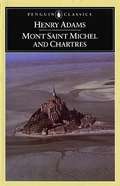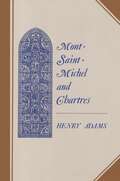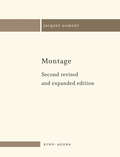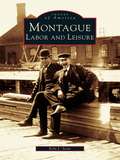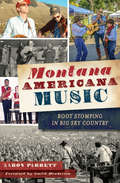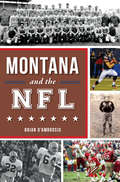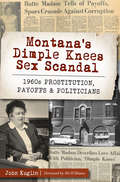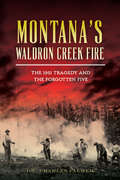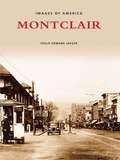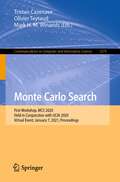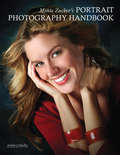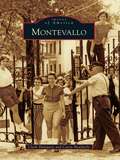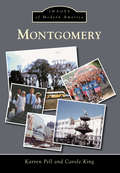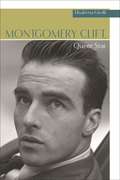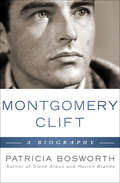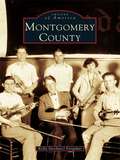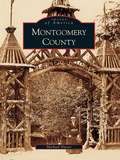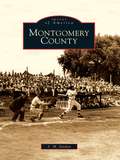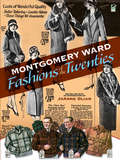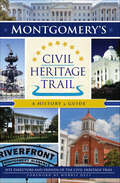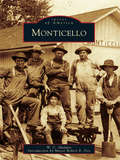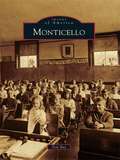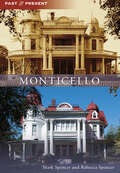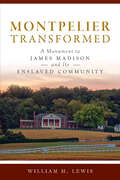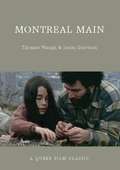- Table View
- List View
Mont-Saint-Michel and Chartres
by Henry Adams Raymond CarneyMont Saint Michel and Chartres is a record not of a literal jouney but of a meditative journey across time and space into the medieval imagination. Using the architecture, sculpture, and stained glass of the two locales as a starting point, Adams breathes life into what others might see merely as monuments of a past civilization. With daring and inventive conceits, Adams looks at the ordinary people, places, and events in the context of the social conventions and systems of thought and belief of the thirteenth century turning the study of history into a kind of theater. As Raymond Carney discusses in his introduction, Adams' freeedom from the European traditions of study lends an exuberance--and puckish wit--to his writings.
Mont-Saint-Michel and Chartres: A Study of Thirteenth-Century Unity
by Henry AdamsThis first paperback facsimile of the classic 1913 edition includes thirteen photographs and numerous illustrations of the great cathedrals of Northern France. Henry Adams referred to this book as "A Study of Thirteenth-Century Unity," and its expansive scope, together with the author's deep understanding of the period, makes it a classic in art history as well as in American literature. He wrote, "I wanted to show the intensity of the vital energy of a given time, and of course that intensity had to be stated in its two highest terms-religion and art." Henry Adams' record of his journeys through France, searching for images of unity in an age of conflict, is accompanied by observations on literature, politics, religion, and maior church leaders such as Abelard, St. Francis of Assisi, and St. Thomas Aquinas.
Montage (Theories Of Representation And Difference Ser.)
by Jacques AumontDescribing editing as cinema's formal and aesthetic soul because of its ability to represent time, in this wide-ranging essay Jacques Aumont surveys the theory and practice of editing and montage from early cinema to the digital era. Aumont addresses the Soviet filmmaker-theorists of the 1920s, of course – he is a translator of Eisenstein and the author of a book on Eisenstein's montage – but also brings into the discussion contemporary directors such as Jia Zhangke, Abbas Kiarostami, Aleksandr Sokurov, Kathryn Bigelow and Lisandro Alonso, with stops along the way for the ideas of André Bazin, Jean-Luc Godard and Pier Paolo Pasolini. This original essay is essential reading by one of the leading film scholars at work in the world today and a rare opportunity for English speakers to enjoy his work. This expanded and revised edition adds a dozen pages to the original volume. "We have entered into a period in which the reign of vision has become contested by that of the image, with the result that editing has changed nature, because its job is no longer to regulate a succession of shots as much as it is to regulate a succession of images. And while the shot has a responsibility towards reality, the image is responsible only to itself." — Jacques Aumont
Montague: Labor and Leisure (Images of America)
by Kyle J. ScottMontague, a picturesque New England town, was once a hub of manufacturing. This uniquely planned community was established in an area that was well suited to both labor and leisure. The Great Falls offered the power to cover the energy needs for the countless factories along the river's edge as well as its man-made power canal. The newly planned village of Turners Falls and the pleasant living conditions of Montague's other villages led to a growth in population at the beginning of the twentieth century. Immigrants from all over the globe added to the diversity of Montague. The historical photographs in Montague Labor and Leisure show one hundred thirty-five years of captivating history.
Montana Americana Music: Boot Stomping in Big Sky Country
by Smith Henderson Aaron ParrettMontana's relationship to Americana music is as wide and deep as the famed Missouri River that inspired countless musicians seated at its shores. From the fiddling of Pierre Cruzatte and George Gibson in the Corps of Discovery to the modern-day loner folk of Joey Running Crane and Cameron Boster, the Treasure State inspires the production of top-notch country music. In the 1950s, bands like the Snake River Outlaws fostered a long-standing love of hillbilly honky-tonk, and in the 1970s, the Mission Mountain Wood Band added a homegrown flavor of its own. Contemporary acts like the Lil' Smokies and songwriter Martha Scanlan promise a vibrant future for the local sound. Author and musician Aaron Parrett explores this history to show what it means to boot stomp in Big Sky Country.
Montana and the NFL (Sports)
by Brian D'AmbrosioMontanans' football obsession goes far beyond storied college programs. From Baker to Zurich, even the tiniest towns in Montana have sent players to the NFL. One of the most dominant offensive linemen of the 1940s was Anaconda's own Francis Cope, who earned All-Decade honors as a New York Giant. Elected to the Pro Football Hall of Fame in 1991, MSU alum Jan Stenerud was the league's first soccer-style kicker. Pat Donovan, who earned a Super Bowl ring with the Dallas Cowboys in the 1970s, was named by Sports Illustrated as the fourth-greatest Montana athlete of the twentieth century. Griz Doug Betters was a member of the Miami Dolphins' famed Killer Bees and the 1983 NFL defensive player of the year. From the obscure to the prominent, author Brian D'Ambrosio celebrates Big Sky Country's rich connections with America's favorite professional sports league.
Montana's Dimple Knees Sex Scandal: 1960s Prostitution, Payoffs and Politicians (True Crime)
by Pat Williams John KuglinBeverly Snodgrass made a lot of poor choices. Once a prostitute in the old mining town of Butte, she later became a madam running two of the most popular brothels. She fell deeply in love with a crooked politician, whom she nicknamed "Dimple Knees." When corrupt cops in uniform came to her businesses, it usually wasn't to serve and protect but rather to collect payoffs. Butte is sometimes described as a town that "drinks her liquor straight," but things never were the same after Beverly told her story to a newspaper reporter. That reporter, John Kuglin, recounts the scandal that rocked The Richest Hill on Earth and for a time made Dimple Knees the most famous name in Montana.
Montana’s Waldron Creek Fire: The 1931 Tragedy and the Forgotten Five (Disaster Ser.)
by Dr Charles PalmerOn August 25, 1931, five men died fighting the devastating Waldron Creek Fire west of Choteau, Montana. Lacking training and preparation, Herbert Novotny, Frank Williamson, Hjalmer G. Gunnarson, Ted Bierchen and Charles Allen dashed into the flames and never stood a chance. The Teton County coroner added insult to injury, noting that each had "no one to blame but himself." Three men were buried in unmarked graves. Records show that the body of the fifth was returned to his family, but no burial site is known. Only one has a headstone. National Smokejumper Association chief historian Dr. Charles Palmer shines a light on this important story, finally honoring the heroic sacrifice that led to critical changes in wildland firefighting.
Montclair: A Postcard Guide To Its Past (Postcard History Series)
by Philip Edward JaegerMontclair, New Jersey, like most American towns, has grown dramatically over the course of the last one hundred years. Much of the early 1900s landscape has been disguised, and the town has come to reflect the popular styles and fashions of changing eras. Streets have been paved, the facades of commercial buildings have been updated, andhomes have been altered to reflect contemporary tastes and accommodate modern conveniences. This volume of approximately two hundred postcards from the author's collection, most never before published in book form, captures Montclair as it was in the early twentieth century. The reader will see familiar landmarks such as the Montclair Art Museum, the Marlboro Inn, and the Bellevue Theater as they originally appeared, and discover the vanished predecessors of the Japanese-style mansion on Upper Mountain Avenue and the Rockcliffe Apartments off Crestmont Road.
Monte Carlo Search: First Workshop, MCS 2020, Held in Conjunction with IJCAI 2020, Virtual Event, January 7, 2021, Proceedings (Communications in Computer and Information Science #1379)
by Tristan Cazenave Mark H. M. Winands Olivier TeytaudThis book constitutes the refereed proceedings of the First Workshop on Monte Carlo Search, MCS 2020, organized in conjunction with IJCAI 2020. The event was supposed to take place in Yokohama, Japan, in July 2020, but due to the Covid-19 pandemic was held virtually on January 7, 2021. The 9 full papers of the specialized project were carefully reviewed and selected from 15 submissions. The following topics are covered in the contributions: discrete mathematics in computer science, games, optimization, search algorithms, Monte Carlo methods, neural networks, reinforcement learning, machine learning.
Monte Zucker's Portrait Photography Handbook
by Monte ZuckerMaster of portraiture Monte Zucker presents page after page of essential photographic lessons to enable photographers to achieve and exceed their financial and artistic goals. Providing instructions on how to conduct a well-crafted client consultation, readers will learn which angles of the face to photograph, how to pose the body, where to place the camera, and the proper positioning of lighting equipment in order to cultivate an emotional connection with clients to produce an ideal image. Chapters with expert advice on digital imaging cleanup and finishing techniques, clothing and makeup selection, and location and studio backdrop options to reinforce portrait concepts are also included.
Montevallo
by Carey Heatherly Clark HultquistMontevallo: a mountain in a valley. This bucolic, natural phrase aptly describes the beauty of this central Alabama town. Early settlers were drawn to the area by its abundant agricultural and mineral resources, and in 1826, the tiny village of Montevallo was born. The nature of the town changed significantly in 1896 with the founding of the Alabama Girls' Industrial School, now the University of Montevallo. The Olmsted Brothers firm of Brookline, Massachusetts, laid out the central campus, and its master plan still inspires current development. Since 1896, the focus of the town has shifted from agriculture and mining to education. The university's mission is to be Alabama's "Public Liberal Arts College." Prominent figures include writer and veteran E. B. Sledge, actresses Polly Holliday and Rebecca Luker, and Major League Baseball player Rusty Greer.
Montgomery
by Carole King Karren PellThis book looks at the changes in Alabama's "Capital City of Dreams." During World War II, Montgomery residents opened their homes and hearts to pilots at Maxwell and Gunter Air Force Bases. During the postwar boom, downtown flourished as homes and shopping centers emerged in suburbia. In the 1950s and 1960s, Montgomery became an important site of the civil rights movement. The 1970s brought urban renewal, while the 1980s focused on the arts with the Alabama Shakespeare Festival, the construction of the Montgomery Museum of Fine Arts, and the restoration of the Paramount Theatre as the Davis Theatre for the Performing Arts. Montgomery's current downtown renaissance features the restoration of historic buildings for use as restaurants, retail shops, and a baseball stadium.
Montgomery Clift, Queer Star
by Elisabetta GirelliStrikingly beautiful and exceptionally talented, Montgomery Clift was at the peak of his fame in 1956 when a devastating car crash nearly destroyed his face. While this traumatic event robbed him of his heartthrob status and turned him into a somewhat disturbing, socially alienated character, author Elisabetta Girelli argues that Clift had always combined on-screen erotic ambiguity with real-life sexual nonconformity. In Montgomery Clift, Queer Star she maps the development of Clift's subversive image over the span of his entire career, approaching Clift as a queer signifier who defied normative cultural structures. From the sexually ambivalent "beautiful boy" of his early films, to the seemingly asexual, transgressive, and often distressed man of his last years, Girelli argues that Clift shows remarkable consistency as a star: his presence always challenges established notions of virility, sexuality, and bodily "normality." Girelli's groundbreaking analysis uses queer theory to assess Clift's disruptive legacy, engaging with key critical concepts such as the closet, performativity, queer shame, crip theory, and queer temporality. She balances theoretical frameworks with extensive close readings of his performances and a consideration of how Clift's personal life, and public perceptions of it, informed his overall image as a deviant star and man. Montgomery Clift, Queer Star offers a comprehensive critical assessment of Clift through classic texts of queer criticism, as well as new interventions in the field. Scholars of gender and film, performance studies, queer and sexuality studies, and masculinity studies will appreciate this compelling study.
Montgomery Clift: A Biography (Limelight Ser.)
by Patricia Bosworth&“The definitive work on the gifted, haunted actor&” (Los Angeles Times) and &“the best film star biography in years&” (Newsweek). From the moment he leapt to stardom with the films Red River and A Place in the Sun, Montgomery Clift was acclaimed by critics and loved by fans. Elegant, moody, and strikingly handsome, he became one of the most definitive actors of the 1950s, the first of Hollywood&’s &“loner heroes,&” a group that includes Marlon Brando and James Dean. In this affecting biography, Patricia Bosworth explores the complex inner life and desires of the renowned actor. She traces a poignant trajectory: Clift&’s childhood was dominated by a controlling, class-obsessed mother who never left him alone. He developed passionate friendships with Marilyn Monroe and Elizabeth Taylor in spite of his closeted homosexuality. Then his face was destroyed after a traumatic car crash outside Taylor&’s house. He continued to make films, but the loss of his beauty and subsequent addictions finally brought the curtain down on his career. Stunning and heartrending, Montgomery Clift is a remarkable tribute to one of Hollywood&’s most gifted—and tormented—actors.
Montgomery County
by Kelly Yacobucci FarquharWith a rich and varied history spanning almost three hundred years, Montgomery County suffered during the Revolutionary War, prospered with the Erie Canal and the railroad, and changed in the age of urban renewal. Located in the heart of the Mohawk Valley in upstate New York, the county experienced the arrival of Dutch and Palatine German settlers, the passage of travelers heading west through the Noses, the pre-suffragist sojourn of Susan B. Anthony, and the swift success of the carpet industry. All of this is compellingly retold in Montgomery County, a broad look at the people, industry, culture, and architecture that make up the county's history.
Montgomery County
by Michael DwyerNicknamed the "Gateway to the Nation's Capital," Montgomery County is home to a number of federal agencies and a highly educated and affluent population that has grown increasingly diverse in recent years. Established in 1776, Montgomery County now consists of urban centers like Bethesda and Silver Spring; suburban neighborhoods like Wheaton, Germantown, and Potomac; and scenic rolling farmland interspersed with historic villages, like Brookeville and Barnesville. An additional 50,000 acres of federal, state, and county parkland provide numerous recreational opportunities for its residents.
Montgomery County
by S. M. SendenMontgomery County was one of the last areas in Iowa to be settled. For many years it was considered to be uninhabitable and of little value-until the men and women with hopes and dreams began to settle, build towns, and till the rich, fertile soil. The Forks, Binn's Grove, Hungry Hollow, Frankfort, Milford, Red Oak Junction, Stanton, Villisca, and many more settlements came into being, budding with promise, but the coming of the railroad determined the survival of them all. Some are still thriving cities, while others are no more than a fading memory that only the winds of the prairie can recall.
Montgomery Ward Fashions of the Twenties
by Joanne OlianWhat were they wearing during the Roaring 20s? This chic collection presents a comprehensive view of Jazz Age fashions with hundreds of sepia-tone illustrations and captions. Selected from a 1927 Montgomery Ward catalog, these images form authentic reflections of the era's everyday and formal apparel. For the ladies, the catalog abounds in "rage of Paris" chemise dresses, feather-trimmed cloche hats, and casual wear. Gentlemen's suits appear here as well, along with attire for work and leisure and children's clothes for school, play, and special occasions. Sixteen pages of color illustrations offer vivid portraits of '20s styles, and an informative Introduction by fashion historian JoAnne Olian explains the period's trends. Collectors, designers, and fashion mavens will prize this charming style archive.
Montgomery's Civil Heritage Trail: A History & Guide (Landmarks)
by Site Directors Friends of the Civil Heritage TrailMontgomery's cultural heritage reflects two of America's most transformative struggles: the Civil War and the civil rights movement. On February 18, 1861, Jefferson Davis was inaugurated as president of the Confederate States of America on the Alabama Capitol steps. Those same steps marked the final destination of the Selma-Montgomery voting rights march on March 25, 1965. The telegram to fire on Fort Sumter originated from the Winter Building on Court Square on April 11, 1861. Just down the street, and a century later, Mrs. Rosa L. Parks refused to give up her seat, sparking the Montgomery Bus Boycott. Discover these compelling stories and more surrounding the historical landmarks along Montgomery's Civil Heritage Trail.
Monticello
by W. C. Madden Mayor Robert FoxMonticello was founded by the White County commissioners in 1834 on a bluff above the Tippecanoe River. They named it after the mansion ofThomas Jefferson, the third president of the United States. It was incorporated as a town in 1862. The county seat grew more rapidly when the railroads cameto town before the Civil War. Then the town grew large enough to become a city in 1909, and a mayor was elected. The area around the city became atourist destination in the 1920s after dams created the twin lakes--Shafer and Freeman--and Ideal Beach was conceived. It was renamed Indiana Beach in the 1950s and became the largest entertainment park in the state. In 1974, a devastating tornado roared through downtown Monticello, killing eight people and destroying a large part of the city. However, the people of Monticello banded together to reconstruct a stronger community. Today the city of Monticello is a thriving, progressive community growing in population and size. About a milliontourists come to the area each summer to relax and have fun.
Monticello
by Tom RueLatin for "heavenly mountain," Monticello's founders supported Thomas Jefferson's populist ideals, naming their village for his Virginia home. Center of the Town of Thompson and seat of Sullivan County since 1809, Monticello was founded in 1804 and incorporated in 1830 by John and Samuel Jones. Tanning, lumbering, farming, and manufacturing gave way to tourism. The railroad came in 1871. A fire in 1909 decimated the downtown, but automobiles and an artery nicknamed "the Quickway" connected New York City to the mountains and made Monticello a recreation center. The years 1920 to 1930 saw a population increase of 48 percent. Sidewalks brimmed with shoppers as Broadway, lined with stately and beautiful shade trees, clattered with traffic at all hours. Slightly over an hour from Manhattan, Monticello had two identities: a community built and sustained by workers, residents, and businesses and a busy "borscht belt" vacation center of boardinghouses, hotels, bungalows, and recreation.
Monticello (Past and Present)
by Mark Spencer Rebecca SpencerThe 1872 French castle courthouse set the tone for construction in Monticello. Numerous elegant churches, residences, schools, and civic buildings followed.
Montpelier Transformed: A Monument to James Madison and Its Enslaved Community (Landmarks)
by William H. LewisBy the late 20th century, Montpelier, the home of James and Dolley Madison, had been altered until it would no longer have been recognizable to the couple.In 2000 the newly-created Montpelier Foundation took over management of the historic home with the seemingly insurmountable task of restoring it to be a visual record of the Madisons' era. Within ten years, the Foundation overcame numerous hurdles, turning Montpelier into a monument to the Father of the Constitution. Over the next decade the site also became a monument to Montpelier's enslaved. The buildings in their community next to the Madisons' home were reconstructed, and award-winning exhibits dramatically illustrate the tragedy of slavery and essential role of enslaved people in Madison's life. Foundation co-founder William H. Lewis details the nonprofit's ambitious preservation projects and remarkable achievements.
Montreal Main: A Queer Film Classic
by Thomas Waugh Jason GarrisonA Queer Film Classic: a great Canadian indie film from 1974 that has become a cult classic, about a photographer living among various outcasts in the Montreal neighborhood known as the Main, who becomes obsessed with the teenaged son of friends.
